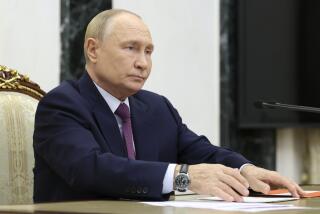U.S. Reaches Out to Allies in Expanded Missile Defense Plan
- Share via
WASHINGTON — The Bush administration unveiled an expanded and evolving missile defense program Tuesday, loosely tying the high-tech weapons to the war against terrorism.
With an unstated focus on North Korea, the administration sought to broaden the program’s appeal to allies, placing a new emphasis on its role in protecting areas far from U.S. borders against attack by nuclear-tipped missiles.
In a White House document known as a national security presidential directive that elaborates on the evolving policy, the administration declared that “the U.S. will develop and deploy missile defenses capable of protecting not only the United States and our deployed forces, but also friends and allies.”
The document was released less than two weeks before President Bush travels to France for the G-8 summit of industrialized nations, several of which -- most notably France, Germany and Russia -- strongly opposed the U.S.-led war against Iraq.
Senior administration officials, speaking on condition of anonymity, presented the document as an effort to reach out for support from other nations, many of which had been skeptical when the United States announced that it was withdrawing from the 1972 Anti-Ballistic Missile Treaty with Moscow to develop a missile defense system.
“You can see a Russian desire to cooperate in the missile defense area,” one senior aide said.
Putting pointed emphasis on the effort to find broadened diplomatic support, the document no longer refers to “national” missile defense, and it states that some systems the United States is pursuing “are inherently capable of intercepting missiles of all ranges, blurring the distinction between theater and national defenses.”
In addition, it emphasized the possibility that foreign contractors could tap into the lucrative defense project.
The administration hopes to deploy the initial stages in 2004. Eventually, six missile defense sites are anticipated in Alaska, while four would be based at Vandenberg Air Force Base near Lompoc. They would be part of a system of interceptors and lasers on land, on aircraft and in space. Additionally, early-warning radar systems would be erected in England and Greenland.
At its most rudimentary operation, a missile defense system to be installed in Alaska next year would be able to intercept and destroy North Korean nuclear warheads fired at American cities, Undersecretary of Defense Edward “Pete” Aldridge testified before a congressional committee in March.
But administration officials envisage the system as one that is evolving -- in terms of the area it would protect, the design of the weapons and, they hope, in the support it would receive from other nations.
“The United States will not have a final, fixed missile defense architecture. Rather, we will deploy an initial set of capabilities that will evolve to meet the changing threat and to take advantage of technological developments,” the document states.
As presented by the administration, missile defense is, in the words of one senior official, “an integral part of contemporary deterrence.”
As such, it reflects a sharp shift from a philosophy that began during the Cold War, when deterrence was based on the doctrine of “mutually assured destruction” -- in effect, forestalling a nuclear attack by threatening certain and devastating retaliation.
With the diplomatic evolution away from Cold War tensions and Washington’s growing alliance with Russia, the deepest concerns are of missile attacks from North Korea, and the possibility that terrorists could obtain a nuclear device. “This document represents the next step in this administration’s approach in meeting the challenge of weapons of mass destruction,” a senior Bush aide said.
Development of a missile defense system has been given new urgency with North Korea’s effort to build a ballistic missile capable of carrying nuclear warheads to the United States.
Defense Secretary Donald H. Rumsfeld testified before Congress in February that the North Koreans “very likely do have a two-stage [rocket] ... which could reach the United States.” Intelligence reports have said North Korea is also developing a longer-range, three-stage rocket, and other defense officials have said that Iran could have a missile capable of reaching the U.S. by the middle of this decade.
More to Read
Sign up for Essential California
The most important California stories and recommendations in your inbox every morning.
You may occasionally receive promotional content from the Los Angeles Times.













